Online retail sales as a proportion of total retail revenue grew to 8% in the 2024 calendar year and is on track to reach double digits in the coming months.
This is according to the Online Retail in South Africa 2025 report by World Wide Worx, which collated online shopping and consumer survey data for 2024.
“Total retail sales reached R96-billion in 2024 and are estimated to reach R130-billion in 2025,” said World Wide Worx CEO Arthur Goldstuck.
The report shows online shopping grew by 35% year over year in 2024, matching growth in 2023.
The study found that disposable income is playing a larger role in determining which demographics are likelier to shop online in South Africa.
Whereas previous editions of the report showed that younger people – those aged under 34, dominated online shopping in the past, there was significantly more growth in spend among older shoppers in 2024.
Shifting older
The number of South Africans between 25 and 34 shopping online grew by five percentage points from 35% in 2023 to 40% in 2024. Similarly, the 45-64 age category increased its proportion of online shoppers by three percentage points from 31% in 2023 to 34% in 2024.
According to Goldstuck, the link between age and online shopping spend is driven by levels of disposable income, with older shoppers likelier to have more disposable income than younger ones. A closer look at online spending data by income level highlights this trend in greater detail.
The survey uses a socioeconomic level (SEL) measure, with the highest income earners in SEL 1 and the lowest in SEL 5. The two highest SELs have the highest proportion of survey respondents using online shopping, at 77% in SEL 1 and 56% in SEL 2.
Read: Takealot rides subscription wave to revenue surge
When segmented by weekly spending habits, the three categories of between R30 000 and R40 000, R40 000 and R50 000, and above R50 000 in monthly earnings all had more than 30% of respondents shopping online. Lower income groups shopped less frequently online.
“The biggest earners are now the ones with the biggest appetite for online shopping and are therefore driving that massive growth that we are seeing,” said Goldstuck.
According Goldstuck, it is not so much that the number of people shopping online in South Africa is on the rise, but rather that those already shopping online are swapping out more of their in-store shopping for online alternatives.
Shoprite Group’s online grocery delivery platform Sixty60 has been one of the biggest beneficiaries of this shift, with 16% percent of survey respondents reportedly using the platform most frequently. Homegrown e-commerce platform Takealot continues to dominate the market with 45% of respondents claiming it as the one they use most.
Interestingly, Chinese outfits Shein and Temu were not mentioned among the most used platforms in the country. However, 17% of those using Shein and Temu cited better deals as their number one reason for doing so. Only 7% said they were drawn to these platforms by the possibility of finding unique products.
Card remains the dominant payment method for online retail transactions, with half of all respondents preferring it. Some 26% opted for bank transfers, while 7% used mobile wallets. Buy-now-pay-later (BNPL), a digital version of a lay-by, accounted for only 5% of all payments.
“Cards remain dominant, but Capitec Pay and BNPL show noticeable adoption among younger and mid-income shoppers,” said the report. – © 2025 NewsCentral Media
Get breaking news from TechCentral on WhatsApp. Sign up here.
